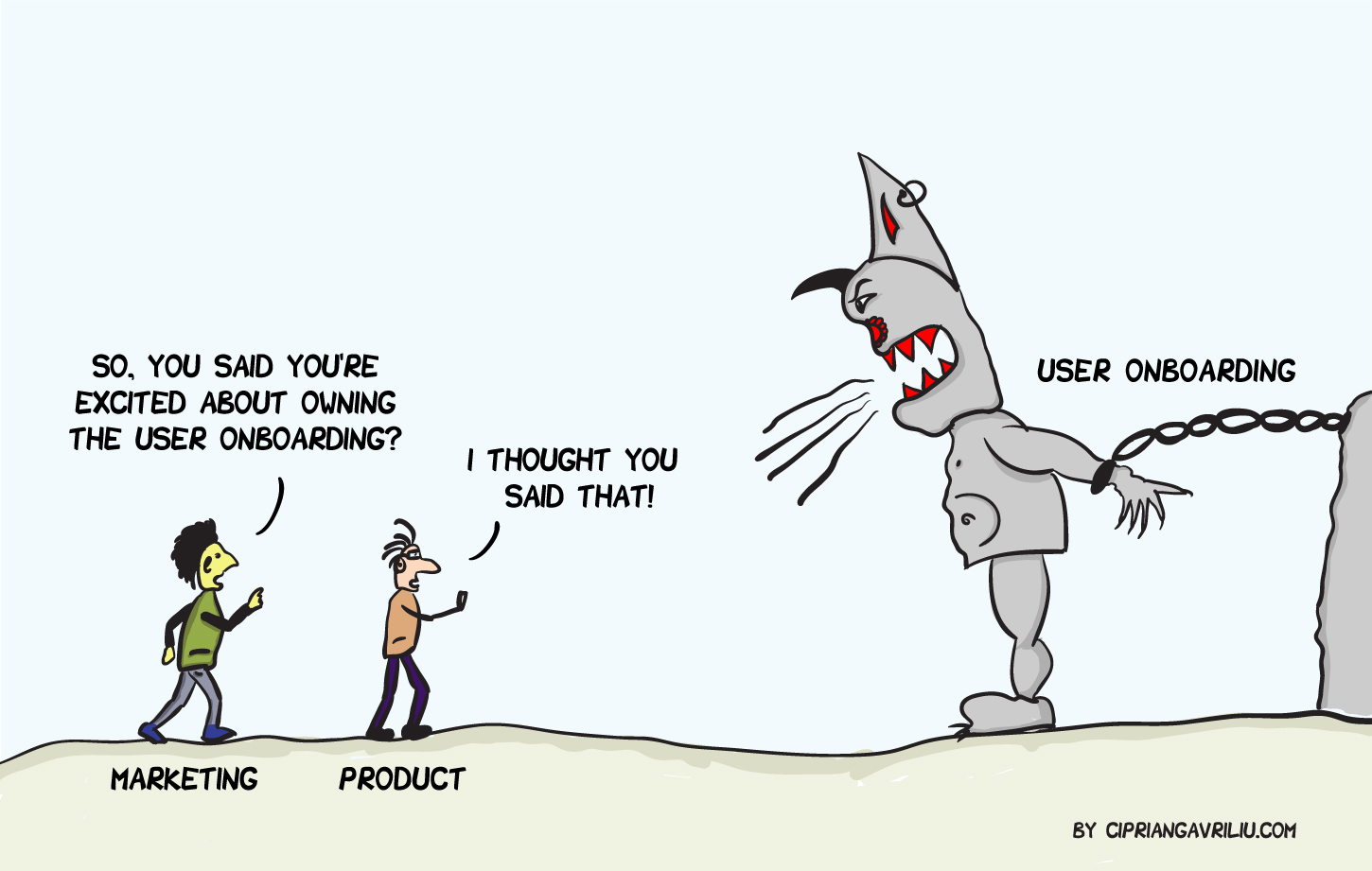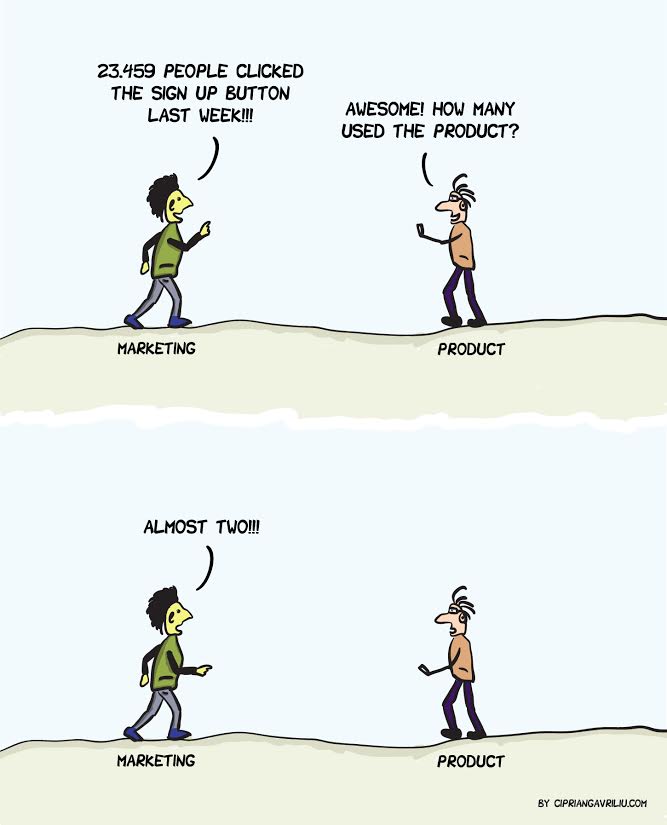For any SaaS company to grow, two things need to happen: The number of new users needs to increase and the churn rate of existing users needs to decrease.
These two metrics are usually the focus of two specific departments or teams: marketing and the product manager.

Every SaaS marketing department wants to increase the number of new users coming into the company.
Specifically, their goal is to bring as many people into the app as they can, while spending the least amount of money.
It’s the product manager and his team who focus on decreasing the churn rate of existing users. His goal is to make the product so spectacular, it has everything it needs to make sure a user never leaves.
So where does the onboarding process fit in?
And, candidly, it’s usually one of those things that everybody thinks the other team should be doing!
New users who are not onboarded can not count toward growth (because they never get far enough along the process so as to become paying customers) and users who don’t onboard churn the moment they sign up.
This is why, despite no one team wanting to claim it as their own, user onboarding is vital.
Therefore, having a clearly defined stakeholder, someone who is ultimately responsible for the onboarding process, is a strong strategy for any SaaS who wants to enjoy consistent growth.
Having worked with a number of teams, helping them optimize their onboarding process, here are the most common problems we faced (and how you can avoid them!)
1. Lead focussed marketing
When the end of a reporting period approaches, sales targets need to be met. What happens? More money is pushed into advertising with the primary focus being how many new people create an account.
Landing pages are cleverly designed to overpromise big benefits, making it easy for people to click the big signup button. New leads flow in and the marketing department congratulates itself for hitting targets.

This would be wonderful if it wasn’t for what happens next. People signup but, almost immediately, abandon the app because they realise it isn’t as easy or as cool as the snazzy landing page promised them it would be.
Promise a potential new user the world and it’s easy to get them to part with their email address or to click ‘Connect With Facebook’. It’s much harder to entice them to actually start using the product.
Far better than targets based on number of signups, targets based on how many people finish onboarding or, at the very least, reach critical steps in the onboarding process, mean that marketing will deliver users to the product managers.
From there, the product manager can monitor and make sure the new user benefits from the features developed for them.
Pro-tip:
When setting AdWords or Facebook conversion codes, don’t only set them for people who created an account but for those that finished the onboarding process as well.
2. Retention focussed product managers
Retention is critical for SaaS success and it’s one of the key metrics used as indicators for the quality of a product or feature.

That’s why product managers focus a lot on this metric. But, retention can only follow activation.
You can’t retain users who signed up but never set up their account.
Pro-tip:
Always check the retention rate of onboarded users. Newly onboarded users have less patience and will engage less than users who have been using your product for some time.
This makes them more sensitive to changes in the app and the quality of the service.
3. Onboarding is not the same as wizards or emails
From our experience, when there is a focus on onboarding, it’s usually the product managers who take it on as their baby.
However, they treat onboarding as a one off project which often only consists of setting up drip email marketing campaigns or in app wizards to guide users through the more difficult steps.
While these are great tactics to optimize onboarding, they only work when the onboarding process is already well thought out. They provide the extra boost, but they’re not enough on their own.
People create an account because they were sold on a promise your website made them.
If the promise changes, the onboarding should probably change as well. Likewise, if the audience and the way you market to them changes, the onboarding process should change too.
Pro-tip:
Keep an eye on how much time people spend completing the onboarding process and what actions they perform, besides the specific onboarding steps.
4. Onboarding is a continuous process
The onboarding process is highly dependent on how the product is marketed. That’s why marketing departments should always be involved in the design of the onboarding experience.

Because marketing is very dynamic, user onboarding should be a continuous process. The first experience a user has with the product will have a big say on whether (or not!) the user is going to come back.
In other words, it has a direct impact on retention. It’s a great starting point for product managers to improve retention.
Pro-tip:
Keep an eye on the trended conversion rate for the onboarding process to spot changes in user behavior.
5. Bridge between product marketers and product managers
Having a stakeholder in charge of the onboarding process (remembering not to treat it as a one time project) will build a solid bridge between marketers and product managers.

Growth doesn’t equal the sum of the results of each department. It accelerates exponentially as each department builds upon the other.
Pro-tip:
Put someone in charge of onboarding and, although he can be from either department, make sure he is always linked to both marketers and product managers.
When it comes to onboarding, have him report directly to the CEO.
Having identified some of the common pitfalls and how best to avoid them, it’s over to you …
Take a look at the teams within your company and identify who is already taking responsibility for your onboarding process.
If there are no clear candidates, it’s time to start thinking about how you can use the issues identified here to tweak and adjust.
Don’t be shy – your company growth needs you!
Looking for deep insights into how your customers use your product?
InnerTrends can help. You won’t have to be a data scientist to discover the best growth opportunities for your business, our software will take care of that for you.
Schedule a Demo with us and witness with your own eyes just how powerful InnerTrends can be.